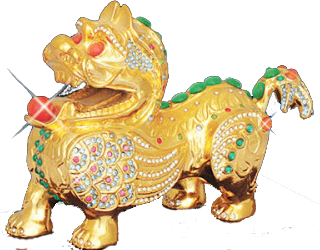Condition Treated / Pain Conditions
Degenerative Spondylitis
Degenerative Spondylitis
Degenerative spondylitis, also called hyperplastic spondylitis, vertebral osteoarthritis, or
senescent arthritis, refers to pathological changes of joints marked by degenerative change
and hyperosteogeny of lumbar cartilages. It is common among the aged, more frequently to be
found in males than in females, often occurring in an early period among those who are obese,
physical workers or sportsmen. It is a kind of lumbar osteoarthritis with chronic pain in the wrist
and leg.
This disease is either primary or secondary. Primary type is a physiological degenerative change among the aged because their tissues and organs are gradually becoming degenerative and the substance of bones has begun to show degenerative change.
The
manifestations of such changes are reduced water or gelation of tissues and organs with
increased free calcium, leading to decline of the physiological function with varied
hyperosteogeny on the margins of lumbar vertebral body, the degenerative changes of
intervertebral discs, narrowing of vertebral space, contraction of intervertebral foramen, which
stimulate and press the nerve root to cause pain in the waist and leg. The secondary type
appears in various injuries, such as chronic inflammation, anemia, disorder of metabolism, or the
endocrine disturbances which affect blood circulation and nutrition supply for chondral plate of
bone joint, and eventually resulting in mucosal inflammation of cartilages and hyperosteogeny,
consequently causing pain in the waist and leg.
The pathological mechanism of this disease is the change of cartilages and degenerative
change of intervertebral discs. After the period of middle age, the elasticity of cartilages
around the vertebral body decreases, and the margins, joint capsules and ligaments gradually
develop protective hyperosteogeny. The fibrous tissues in nucleus pulposus increase with its
original enlargement and gelatine state. After the period of middle age, the degenerative
changes of nucleus pulposus gradually reaches the anaphase, so there are various changes of
intervertebral disc atrophy, such as narrowing of vertebral space and smaller change of
intervertebral foramen. Then the degenerative change of chondral plate is obvious with reduced
fluid exchange, promoting the degeneration and necrosis of nucleus pulposus and annular
fibrosus. The pressure on the posterior vertebral margin increases due to lever action. With the
increase of age, the longer the vertebra experiences the pressure, the more the hyperosteogeny
will appear. After the degenerative changes of intervertebral discs, the vertebral space becomes
narrow and has lost its water support or hydraulic function. As a result, both tips of
vertebral body will be shaken, impacted, and worn continuously. At the same time , the senile
osteoporosis is brought about weakening the resistance of vertebral body to pressure.
Clinical Anifestations of Degenerative Spondylitis
After middle age, lumbago gradually appears without any general symptoms. The period between the
age of 45 and 55 is the peak of lumbago due to retrograde spondylitis. With the increase of age,
the intervertebral disc turns to be atrophic with strengthened stability. Thus after the age of 60,
lumbago gradually alleviates. Other symptoms are whitish or whitish and greasy tongue coating with
deep and tense pulse or soft and moderate pulse.
Usually, lumbago is not severe, just a sort of achig in the waist and inflexible or bounding feeling in the waist. After getting up in the morning or standing up after a long period of sitting, the pain will become evident. However, it may disappear or relieve after some movement, but it can be worsened after overstrain. The pain can be radiated to the buttock and thigh. In the cold and rainy days or after cold attack, it will become severe.
The symptoms are deformity of spine, decrease or disappearance of the physiological protrusion of lumbar, restricted movement of the spine; or the percussion pain in the lumbar spinous processes, tension and tenderness in psoas muscles on both sides, or tenderness in the superior gluteal nerves and sciatic nerves, even symptoms of stimulation in the sciatic nerves. Leg raising test is positive with decreased tendon reflex; bending neck and pressing abdomen test is positive. The X-ray test shows the degree of hyperosteogeny. that hyperosteogeny is in the margin of the waist with the lip shaped bony spur. The vertebral space become narrow or irregular and articular process is vague, accompanied by senile osteanabrosis.
Treatment
1. Therapeutic principles: Promoting Qi and activating blood, soothing tendons and dredging the
collaterals.
2. Location of Acupoints: Mingmen (GV 4), Yaoyangguan(GV 3), Qihaishu (BL
24), Dachangshu (BL 25), Guanyuanshu (BL 26), Jiaji (EX-B 2), Weizhong (BL 40) Yanglingquan (GB
34), Chengshan(BL 57) and waist.
3. Manipulations
Life style recommendations
1. Lie on hard bed and keep the waist warm.
2. Take proper functional exercises, such as bending forwards, extending backwards or rotating the
waist.
Pain Care Acupuncture Clinic is your local acupuncture office in Torrance, CA . specializing in treating injuries and chronic pain. Dr. Ming Chen and Dr. Lu Yang, Both acupuncturists who also the oriental medical doctor ( O.M.D. ) can pinpoint the cause of the injury and suggest the best treatment methods for you. You need our doctor to listen to the whole story and examine you, so that you can get started treating on your injuries or chronic pain and get you on the track toward recovery.
Call now for a free health consultation !
Visit out Pain Care Acupuncture Clinic in;
21320 Howthorne Blvd., Suite 203 Torrance, CA 90503
quick link
Condition Treated
- Pain Conditions
- Respiratory System Conditions
- Digestive System Conditions
- Circulatory System Conditions
- Blood System Conditions
- Endocrine System Conditions
- Nervous System Conditions
- Urogenital System Conditions
- Gynecological Conditions
- Tumour Conditions
- Emotional/Behaviour Conditions
- Sensor Organ Conditions
- Skin Conditions
- Other Conditions















